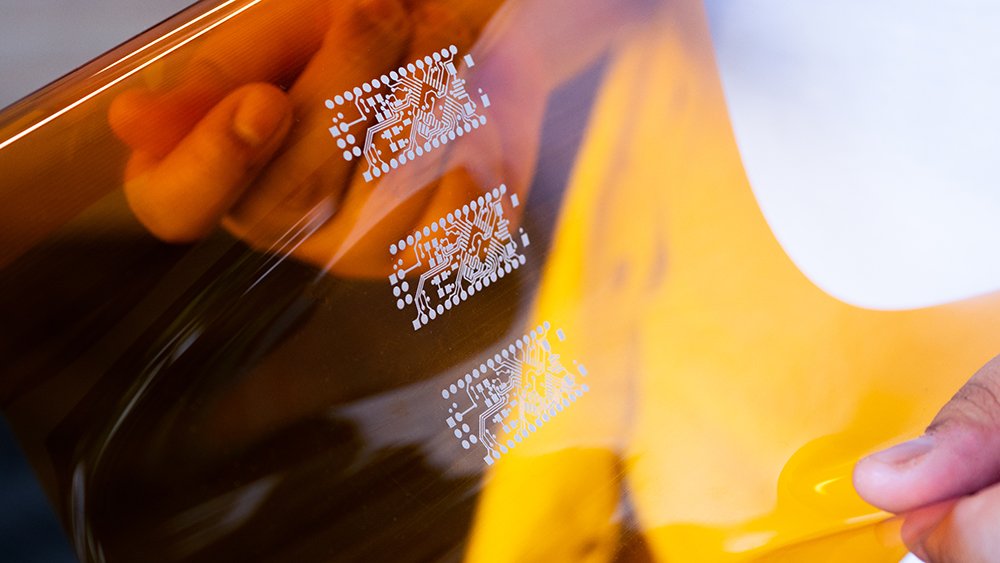Groundbreaking Research In Printed Electronics Using Voltera Dispensing Systems

See some of the diverse applications being developed using NOVA and V-One. Learn about printing biomedical tattoos, electrospray emitters, structural health monitoring, smart facemasks and more.
Introduction
Estimated read time: 7 minutes
It seems there is news about novel products and research in the electronics industry almost every day, and one thing that is abundantly clear is that building the next generation of electronics means that electronics must be bendable, conformable to uneven surfaces, stretchable, and in some cases, even biodegradable.
In this article, we’ll take a look at some of the groundbreaking research by Voltera users.
Additively Manufacturing High-Performance, Low-Cost Electrospray Ion Sources for Point-of-Care Mass Spectrometry
Massachusetts Institute of Technology (MIT)
Graduate researcher at MIT’s Velasquez Group, Alex Kashkin, used Voltera’s NOVA dispensing system in his research to additively print electrospray emitters for point-of-care mass spectrometry.
Mass spectrometry depends heavily on electrospray ionization for the transfer of liquid samples to a gaseous state, allowing for a highly accurate analysis of the fluid’s composition.
In a clinical setting, mass spectrometry is used for:
- Toxicology
- Metabolism deficiencies
- Steroid analysis
- …and more
Electrospray involves applying a high voltage to a liquid sample to generate an electric field, which then converts the liquid into tiny charged droplets. These atomized droplets split into charged ions which allow for the transition into a gas.
Clinical mass spectrometry faces issues pertaining to the development of strong sample processing. Furthermore, the use of internal emitters in the process of electrospray ionization presents difficulties such as sample clogging and multi-device integration.
The benefits of 3D printed emitters are:
- High resolution print results
- Cost effectiveness for bulk fabrication
As noted in his research, Kashkin used NOVA to dispense a silver nanoparticle-based ink onto an electrospray emitter mounting pad on a PCB using a 225 µm nozzle.
“...the silver ink is deposited on the electrospray emitter mounting pad on the PCB before the nozzle is retracted, stretching the ink into a pointed emitter; after that, the emitter is annealed at 100 °C. This novel approach to make electrospray emitters is fast (about 1 s to print the emitter and 5 minutes to anneal it) and requires no further surface coatings: the ~5 µm surface roughness is enough to wick liquids with a low contact angle on the emitter, allowing for electrospray to occur with volatile solvents such as isopropanol without further post-fabrication. Furthermore, to the best of our knowledge, this is the first report of a direct printing method of working, ambient electrospray emitters in the literature.”
Inkjet and Extrusion Printed Silver Biomedical Tattoo Electrodes
York University
Research conducted by Yoland El-Hajj et al. at York University in Toronto studied the applications of silver biomedical electrodes printed on tattoo paper.
Traditional biomedical electrodes are commonly used for electrocardiograms (ECG/EKG), electromyography (EMG), and electroencephalogram (EEG) procedures. These electrodes, however, “are susceptible to motion artifacts, can be uncomfortable for the user, and are unsuitable for long term use,” according to El-Hajj et al.
Their research compared two different printing methods for the electrodes — inkjet and extrusion, the latter being printed using NOVA. Both methods used silver ink due to its high conductivity, mechanical robustness, biocompatibility, and moderate cost.
Their findings indicated that while inkjet printed electrodes are better suited for signal acquisition on areas of the body engaged in higher movement, there was an issue with ink absorbing into the paper substrate. Extrusion printed electrodes (using NOVA) showed a lower sheet resistance and impedance, and also did not absorb into the paper substrate.
Inkjet vs. Extrusion Sheet Resistance
- Extrusion printed electrodes: 9.4 mΩ/sq
- Inkjet printed electrodes: 25.1 kΩ/sq
Inkjet vs. Extrusion Impedance
Results
When summarizing how NOVA assisted her research, El-hajj observed that NOVA made printing on tattoo paper, a highly unconventional substrate, more efficient, and that calibrating materials and aligning patterns was easier compared to other printing methods, including inkjet.
A Robust Printed Strain Sensor for Large-Area Structural Health Monitoring
University of Southern California
The focus of this research was on providing preventative monitoring to reduce the impact of natural disasters on aging infrastructure.
Continuous structural health monitoring analyzes and detects deterioration and damage in infrastructure, providing real-time data useful for timely maintenance and preventing serious issues. However, current strain sensors have limitations that affect their potential. These sensors have more brittle properties which makes sensing on curved areas difficult. Moreover, their rigidity requires a uniform surface to bond for precise measurements. These limitations create a demand for robust and flexible strain sensors.
Using NOVA, the researchers developed multiple sensors by first printing with SE1502 from ACI Materials, a stretchable and conductive carbon ink, onto a 50 µm thick polyimide substrate. After thermally curing the first layer, a second layer was printed using a stretchable silver ink, SE1109 from ACI Materials. The entire sensor was then cured again and cut into multiple pieces to be connected to the readout system.
When printing both carbon and silver ink with NOVA, the results demonstrated sensing architecture capable of achieving high strain sensitivity while also exhibiting a highly robust interconnection to external readout electronics. Their research presents promising benefits for the future of structural health monitoring.
Smart Facemask for Wireless CO2 Monitoring
University of Granada
During the COVID-19 pandemic, facemask wearing was widely imposed by a number of countries, as recommended by the World Health Organization. While this helped reduce community transmission of the virus, there were concerns about potential adverse effects caused by prolonged usage — primarily CO2 rebreathing.
Pablo Escobedo et al., from the University of Granada in Spain, set out to develop a real-time sensing platform for gaseous CO2 inside FFP2 face masks (N95 or KN95 equivalent). This involved printing a flexible near-field communication tag (NFC) sensor and placing it in the FFP2 mask.
The sensor involved combining an opto-chemical sensor with a flexible NFC tag antenna which would track the wearer's CO2 exertion and transmit the data in real-time to a custom smartphone application for alert management, data processing, and data sharing. Because NFC technology relies on energy obtained from the electromagnetic field generated by a remote reader, the tags could operate without battery power, providing significant benefits like lower weight, less maintenance, increased comfort, and reduced environmental impact.
The tag was printed onto a 125 µm-thick PET substrate using Voltera’s flexible silver conductive ink. After the circuit was printed, the ink was cured and solder paste was dispensed onto the components’ footprints and via pads and the electronic components and bridges were manually placed on the soldered areas. The final phase was reflowing the tag and submitting it to various bending tests.
Following the printing process, the sensor was subjected to further testing, such as bend, ambient light, and sensor lifetime testing
Printing Electronics Directly onto Carbon Fiber Composites: Unmanned Aerial Vehicle (UAV) Wings with Integrated Heater for De-Icing
York University
Unmanned aerial vehicles (UAVs) are commonly used to deliver items and gather information in remote areas. They often encounter ice build up on their wings which greatly affects their flight performance. It distorts airflow, increases drag, and reduces maximum lift.
Research by Mohamad K. Idris, et al, from York University, involved printing a self-heating composite structure that can be integrated onto an aircraft's wings for de-icing.
The group used Voltera’s V-One PCB printer to print Creative Materials’ 120-07 silver conductive ink (26,000 - 30,000 cP) using a 225 µm nozzle onto carbon fiber weaves to produce a large-area heater. These silver electrodes are used to run an electrical current through the carbon fiber weaves, which enables power dissipation in the form of heat in order to de-ice the UAV’s wings.
The group determined their work “exploits the electrical and thermal conductivity of carbon fiber to create self-heating composites that could be integrated into UAVs for de-icing. The manufacturing of the integrated heating devices is based on commonly used composites manufacturing methods with the addition of a printing step to create electrical contacts. The devices were manufactured, and temperature measurements were taken using an infrared camera. Results show that the heating devices have been successfully fabricated and can achieve high temperatures suitable for melting ice on UAVs.”
As noted in the paper, “printing electronics on textiles is a challenge because of the large surface roughness of textiles.” They determined their work “presents a new method with the optimized parameters to use extrusion printing to print on textile composites, mainly carbon fiber weaves.”
Not only did researchers at York University develop a repeatable and scalable process for manufacturing carbon fiber-based heating devices, but also, “since extrusion printing is a contactless digital printing method, the proposed methods allow for the facile variation of the pattern design to create various types of electronic devices and circuits.”
Conclusion
Each paper mentioned in this article exemplifies the increasing demand of additive electronics worldwide, and further capitalizes on a wide range of technological applications. Voltera’s platforms not only streamline research and development processes, but they also offer users the ability to print high resolution with ease.
Do you have questions about printing electronics with one of Voltera’s platforms? Email us at [email protected].
Related Articles

Horizon Microtechnologies Presents "D-band Horn Antenna" At EuMW 2024

First Community-Centric Collaboration In Sustainable Manufacturing











